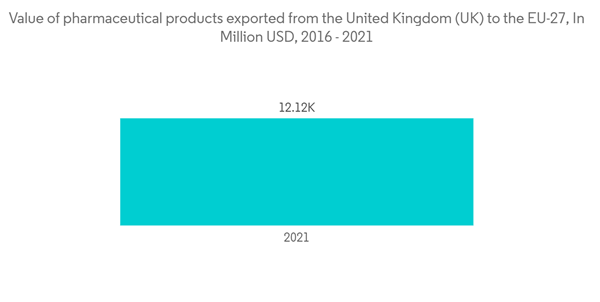Key Highlights
- Globalization has led to the development of more complex logistics systems in the country to manage cross-border shipments, and a growing focus on sustainability has pushed companies to adopt environmentally friendly and socially responsible cold chain logistics practices. Also, the gain in importance of the e-commerce market has improved the need for cold chains across the country. Thus supporting the growth of cold-chain logistics in UK.
- The UK cold chain logistics market is set to grow because more people want fresh food and are paying more attention to safety and where their food comes from. This has led to a rise in demand from supermarkets, which are now contracting directly with producers to make sure they have enough and meet customer needs.
- The UK exports more agricultural goods than any other country and its trade with the rest of the European Union (EU) is a key part of its success. Alongside this, it provides high-quality, efficient agricultural services to many countries worldwide. To support these vital links, there needs to be a reliable and robust logistics system in place. Due to the large population of the United Kingdom and its geographic position, it has an important role in trade with Europe. Air, sea, and land logistics are adequate for transporting goods from origins to end users, but there is room for improvement in the short term.
- By slowing down logistics services, the COVID-19 situation kept creating uncertainty in the market. It stopped companies from growing and made people in different client sectors more and more scared. Governments in several places put full lockdowns in place and temporary closures of industries. This led to border restrictions, making it hard for transportation and logistics services to move. After the COVID-19 health catastrophe, the outlook for companies around the world drastically shifted.
UK Cold Chain Logistics Market Trends
Brexit Pushing the Demand for Refrigerated Transportation
After a no-deal Brexit, it will be very hard for the UK to meet the needs of its people, since the EU is one of its main trading partners in the food and drink industry.To get more exporters, the country has cut the taxes on agricultural products from outside the Union.The European Union is by far the biggest importer of meat, beef, seafood, and drinks from the United States.For the nation, developing a market outside the Union will be a difficult undertaking.
Potential trading partners for the nation include nations like Chile, Australia, and Africa. However, these nations are farther away from the EU than the UK, making trade with them difficult and necessitating cutting-edge cold chain services.
Along with the food and drink industry, the pharmaceutical industry will also have problems due to the possibility of drug shortages. Several big drug companies, like Bayer, Novartis, AstraZeneca, and GSK, have taken steps to make sure they have enough medicine. For example, the leading diabetes pharmaceutical companies in Europe, Novo Nordisk and Sanofi, are hoarding insulin in Britain, which is driving up the need for cutting-edge cold storage facilities.
Growth In Pharmaceutical Sector
According to Association of the British Pharmaceutical Industry, Customers in the UK spent close to USD 13.25 billion on pharmaceuticals in 2021. The sales value of pain relief products sold over-the-counter (OTC) increased by 5.2 percent from the previous year. Most of the time, pain relievers, vitamins and minerals, and cough and cold medicines are the three most profitable types of over-the-counter (OTC) products.The two biggest pharmaceutical companies in Britain are AstraZeneca, which is based in Cambridge, and GlaxoSmithKline, which is based in London. Based on market capitalization, GlaxoSmithKline held the top spot for a while among UK pharmaceutical firms. Even so, AstraZeneca saw a considerable increase in sales as a result of working with an Oxford University team to create the COVID-19 vaccine. According industry reports, AstraZeneca was said to have a market capitalization of over 170 billion British pounds as of November 2022.
UK Cold Chain Logistics Industry Overview
The demand for UK cold-chain logistics services is rising. Many companies say they have experienced a significant increase in demand, particularly for cost-effective solutions that help them achieve flexibility and responsiveness while keeping costs low. In addition to the increased processing and distribution of goods, customer expectations are changing as customers want suppliers to be more socially responsible and address climate change issues.Lineage Logistics and Reed Boardall are just a few of the many foreign and domestic companies that dominate the cold chain logistics business in the United Kingdom. The situation after Brexit is expected to make the already-growing storage and transportation industry grow even more.
Additional Benefits:
- The market estimate (ME) sheet in Excel format
- 3 months of analyst support
This product will be delivered within 2 business days.










